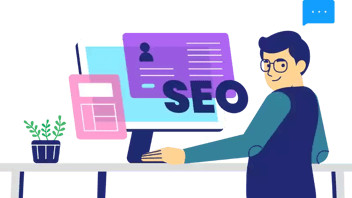Deblocați succesul SEO: Aflați cum folosim HubSpot Hub de conținut pentru SEO, cum stimulăm clasamentele și cum creștem traficul organic.
5 sfaturi: viteză pagină web optimizată. SEO & UX mai bune
Paginile care se încarcă lent sunt blestematele construcției de site-uri web, împiedicând experiența utilizatorului și având un impact negativ asupra eficienței site-ului dvs. web. Optimizarea vitezei paginii dvs. este crucială pentru experiența utilizatorului și SEO, dar nu este la fel de simplu ca apăsarea unui comutator. Această postare vă va ghida prin cinci sfaturi despre cum să utilizați instrumentele SEO pentru a optimiza timpii de încărcare, asigurându-vă că site-ul dvs. este competitiv și ușor de utilizat.

De ce este importantă viteza paginii?
-
O întârziere de 1 secundă în timpul de încărcare a paginii poate duce la o scădere cu 7% a conversiilor. Dacă site-ul dvs. are nevoie de 1 secundă în plus pentru a se încărca, ați putea pierde 7% din potențialele vânzări sau clienți potențiali.
-
Google afirmă că viteza de încărcare a paginii este un factor de clasificare în algoritmul său de căutare. Site-urile webcu timpi de încărcare mai rapizi au mai multe șanse să apară mai sus în rezultatele căutării. Parametrii Google Core Web Vitals măsoară experiența de încărcare a unei pagini web; acești parametri includ întârzierea la prima intrare (FID), cel mai mare conținut (LCP) și deplasarea cumulativă a aspectului (CLS).
-
Încărcarea unui site web mobil durează în medie 19 secunde, ceea ce este semnificativ mai lent decât încărcarea unui site web desktop, care durează în medie 11 secunde.
-
70% dintre utilizatorii de dispozitive mobile vor părăsi un site web dacă încărcarea durează mai mult de 5 secunde. Dacă încărcarea site-ului dvs. web pe dispozitive mobile durează mai mult de 5 secunde, riscați să refuzați o parte semnificativă a traficului dvs.
Menținerea performanței SEO și creșterea continuă a traficului și a conversiilor au devenit mai importante ca niciodată.
1. Obțineți găzduire web de ultimă generație
Optarea pentru o găzduire economică poate părea o mișcare înțeleaptă la început, dar poate compromite viteza site-ului dvs. web și experiența generală a utilizatorului. Rezistați tentației de a reduce calitatea găzduirii de dragul reducerii costurilor.
În calitate de arhitect devotat al site-ului dvs. web, ați investit un efort și o grijă imense în fiecare aspect, creând un tărâm digital care reflectă angajamentul și viziunea dvs. Cu toate acestea, este esențial să recunoașteți că vizitatorii dvs. pornesc într-o călătorie distinctă. Ei tânjesc după un acces rapid și fără efort la informațiile sau serviciile pe care le oferiți. Înțelegerea acestei diferențe este vitală. Acordând prioritate optimizării vitezei paginii dvs., nu numai că răspundeți așteptărilor utilizatorilor dvs., dar și creșteți avantajul competitiv și atractivitatea site-ului dvs. Această dedicare pentru a asigura o experiență de navigare rapidă și fără întreruperi merge dincolo de simpla tehnică; ea întruchipează etosul nostru de inovație, susținere și fiabilitate, cu scopul de a îmbogăți fiecare interacțiune online cu eficiență și semnificație.
Luați în considerare impactul chiar și al unei întârzieri minore. Potrivit Cloudflare, Walmart a observat o creștere de 2% a conversiilor pentru fiecare îmbunătățire de 1 secundă a timpului de încărcare a paginii; COOK a observat o creștere de 7% a conversiilor prin reducerea timpului de încărcare cu 0,85 secunde; Mobify a raportat o creștere de 1,11% a conversiilor pentru fiecare îmbunătățire de 100ms a timpului de încărcare a paginii sale principale.
Cu cât întârziați mai mult, cu atât riscați mai mult să pierdeți răbdarea și interesul publicului dumneavoastră.
Timpul de încărcare a paginii este un element esențial în arena extrem de competitivă a dezvoltării de site-uri web. Dacă rivalii dvs. oferă un produs sau un serviciu comparabil, dar cu timpi de încărcare mai rapizi, aceștia sunt susceptibili de a capta atenția potențialilor utilizatori. Prin evaluarea vitezei de încărcare a site-urilor concurenților dvs. și compararea acestora cu ale dvs., puteți identifica domeniile care necesită îmbunătățiri. Dacă site-urile lor se încarcă mai rapid, este un apel la acțiune pentru a vă îmbunătăți viteza. În schimb, dacă site-urile lor sunt mai lente, optimizarea vitezei paginii dvs. vă poate oferi un avantaj semnificativ. Optarea pentru o găzduire web premium este un pas inițial excelent către îmbunătățirea timpilor de încărcare, asigurându-vă că site-ul dvs. se remarcă atât prin performanță, cât și prin satisfacția utilizatorilor.
2. Optimizarea fișierelor media
Imaginile și videoclipurile de înaltă rezoluție sunt incredibil de accesibile pentru oricine în zilele noastre. Puteți îndrepta camera foto a telefonului și să fotografiați dacă nu găsiți ceea ce doriți online. Acest lucru, combinat cu cât de ușor a devenit să încărcați media pe site-uri web, are ca rezultat faptul că oamenii pun media inutil de mari pe site-urile lor, reducând drastic timpii de încărcare. Este important să optimizați imaginile și clipurile video astfel încât acestea să arate bine, dar să nu vă afecteze viteza paginii.
În ceea ce privește imaginile, este esențial să înțelegeți ce format de fișier funcționează cel mai bine pentru fiecare situație. Formatul JPG este cel mai bun pentru imaginile fotografice. GIF-urile și PNG-urile funcționează mai bine pentru imagini de fundal, imagini la scară largă sau culori solide.
Apoi, trebuie să vă asigurați că imaginile dvs. au dimensiunea potrivită. Dacă site-ul dvs. web va afișa imaginea într-un pătrat de 400x400 pixeli, atunci nu este nevoie să încărcați o imagine de 2400x2400 pixeli. În acel moment, doar creșteți timpii de încărcare, fără niciun beneficiu la final.
Același lucru este valabil și pentru videoclipuri. MP4-urile sunt, de obicei, cea mai bună soluție, deoarece asigură echilibrul perfect între calitate și dimensiunea fișierului. De asemenea, trebuie să vă asigurați că videoclipul dvs. are dimensiunile corecte pentru ecranul utilizatorului - aveți grijă la utilizatorii de dispozitive mobile!
Dacă utilizați un videoclip fără sunet ca element de fundal, puteți edita videoclipul și elimina complet pista audio. Acest lucru vă va ajuta să reduceți și mai mult dimensiunea fișierului și este exact optimizarea detaliată pe care doriți să o urmăriți.
Alternativ, puteți încărca videoclipurile într-un serviciu terț de găzduire video, cum ar fi YouTube, și apoi să utilizați o versiune încorporată a videoclipului pe pagina dumneavoastră. Acest lucru va reduce o parte din încărcarea paginii dvs.
S-ar putea să-ți placă și:
3. Utilizați compresia
Compresia este un alt lucru de care trebuie să profitați. Compresia este utilă în multe moduri în ceea ce privește reducerea dimensiunilor fișierelor și creșterea timpilor de încărcare. Toate mediile pot fi comprimate - imagini, videoclipuri, fișiere audio, orice vă puteți gândi. Mai multe pluginuri vă vor comprima automat fișierele media pentru paginile dvs. web și asigurați-vă că le utilizați.
De asemenea, puteți utiliza compresia GZIP pentru a reduce timpul de descărcare al fișierelor HTML și Javascript. Cea mai bună parte a compresiei GZIP este că toate browserele (inclusiv cele mobile) o acceptă, astfel încât activarea acesteia nu este dificilă.
4. Reduceți solicitările HTTP
Una dintre principalele probleme cu care se confruntă designerii web este că nu proiectează întotdeauna paginile având ca prioritate timpul de încărcare - modul în care arată o pagină sau cantitatea de informații pe care o oferă utilizatorului pot avea adesea prioritate față de viteza paginii. Acest lucru duce, de obicei, la introducerea mai multor fișiere JavaScript și CSS într-o pagină (temele, pluginurile și imaginile sunt cele mai bune exemple), fiecare dintre acestea necesitând solicitarea sa HTTP. Solicitările HTTP necesită timp și adăugați o cantitate semnificativă de timp de încărcare cu fiecare solicitare pe care o adăugați la pagina dvs. Puteți reduce numărul de solicitări HTTP prin:
-
Fuzionarea diferitelor fișiere JavaScript sau CSS în fișiere JavaScript sau CSS unice.
-
Scăpați de cât mai multe pluginuri, în special de cele cu fișiere CSS sau JavaScript pe care trebuie să le încărcați. Unele pluginuri vă permit să dezactivați acest lucru, deci verificați dacă această opțiune este disponibilă!
-
Utilizați sprites pentru imaginile pe care le utilizați în mod regulat (de exemplu, logo-ul dvs.).
-
Încercați să utilizați fonturi în locul imaginilor ori de câte ori este posibil, deoarece fonturile trebuie încărcate o singură dată.
5. Încărcați conținutul above-the-fold cu prioritate
Conținutul above-the-fold este conținutul pe care vizitatorii îl văd înainte de a fi nevoiți să deruleze în jos. Este practic tot ceea ce apare în partea de sus a paginii dvs. în ecranul unui utilizator. Puteți prioritiza încărcarea acestor elemente, deoarece acestea sunt primele lucruri pe care le va vedea utilizatorul, iar apoi pagina dvs. va încărca restul. Acest lucru poate părea puțin neobișnuit, dar nu are rost să încărcați elemente pe care utilizatorul nu le poate vedea imediat.
Fiți cu ochii pe raportul Google Key Web Vitals cu metrici esențiale, cum ar fi Largest Contentful Paint (LCP), First Input Delay (FID) și Cumulative Layout Shift (CLS), menite să ajute dezvoltatorii și proprietarii de site-uri web să îmbunătățească experiența de utilizare a site-urilor lor și creșterea traficului și a conversiilor.
Acest conținut este disponibil și în:
- Germană: 5 Speed-Booster Tipps für bessere SEO und Benutzerfreundlichkeit
- Engleză: 5 Tips to Optimize Page Speed for Better SEO and User Experience
- Spaniolă: Optimizar la velocidad de la página: SEO y UX ¡en 5 pasos!
- Franceză: Optimisez la vitesse des pages pour SEO et une meilleure expérience
- Italiană: 5 consigli per la velocità della pagina, SEO e UX
- Chineză: 优化页面速度以提高搜索引擎优化和用户体验的 5 个技巧









Lasă un comentariu cu părerea ta.